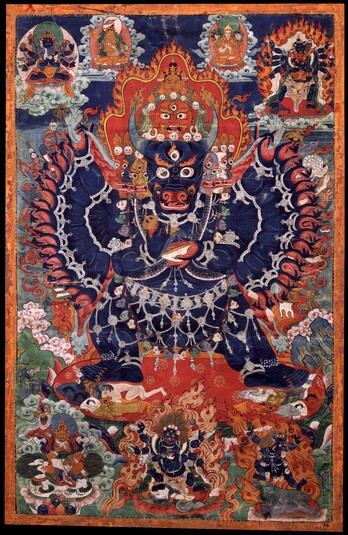
Item: Vajrabhairava (Buddhist Deity) - Solitary (Ekavira)
| Origin Location | Mongolia |
|---|---|
| Date Range | 1800 - 1899 |
| Lineages | Gelug |
| Size | 83.82x55.88cm (33x22in) |
| Material | Ground Mineral Pigment on Cotton |
| Collection | Rubin Museum of Art |
| Catalogue # | acc.# P1999.26.1 |
Classification: Deity
Appearance: Animal-Feature
Gender: Male
Vajrabhairava (Tibetan: dor je jig je. English: the Vajra Terror): wrathful form of the peaceful bodhisattva Manjushri from the classification of Anuttarayoga Tantra.
Jeff Watt 11-2000
Sadhana Description:
??Sri Vajra-mahabhairava (dpal rDo-rje? jigs-byed chen-po), dark blue, with nine faces, thirty-four arms and sixteen legs, abiding in pratyalidha posture (right legs bent). Capable of devouring the three worlds, he is shouting ?Haha? and has rolled-up tongue, bared fangs and a frown. Beside the frown, his eyebrows and eyes blaze like the fire at the time of destruction. His pale yellow hair streams upwards. Threatening the worldly and supermundane gods, he terrifies even the terrible, roaring like thunder the great sound of PHEM and eating human blood, grease, marrow and fat. He is crowned with five frightful dry skulls and adorned with a skull garland of fifty fresh heads, a black snake as scared thread, a circlet of human bone, and earrings and the other ornaments of bone. He is naked of body, with huge belly. His sex stands erect. His eyebrows, eyelashes, beard and body hairs blaze like the fire at the end of time.
From Deities of Tibetan Buddhism, Wisdom Publications, 2000. Translated by Martin Willson from the sadhana text of Phabongkha Dechen Nyingpo (1878-1941): biographical reference.
Subject: Meditational Deity Triad (Gelug)
Tradition: Gelug Deity Paintings
Collection of Rubin Museum of Art: Painting Gallery 8
Buddhist Deity: Vajrabhairava Main Page
Collection of Rubin Museum of Art: Mongolia
Buddhist Deity: Manjushri (Highest Yoga Tantra)
Buddhist Deity: Vajrabhairava Iconography
